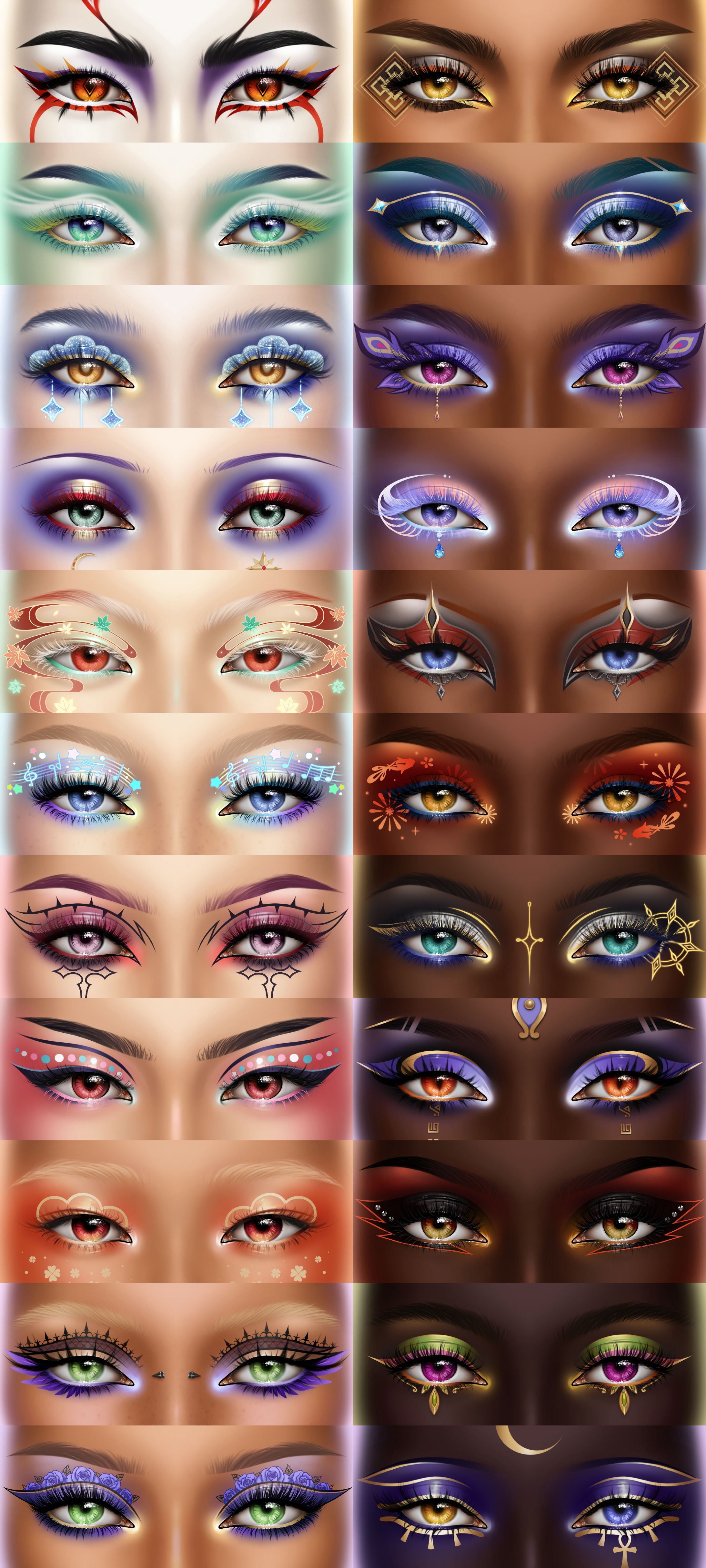The Impact Of Makeup On Skin: A Comprehensive Guide

Table of Contents
The Benefits of Makeup (When Used Properly)
Makeup, when used correctly, offers several advantages beyond aesthetics. Understanding these benefits helps you harness the power of cosmetics responsibly.
Protection from Environmental Factors
Certain makeup products can provide a degree of protection against environmental aggressors.
- Sunscreen in Makeup: Many foundations, tinted moisturizers, and even some powders now incorporate SPF (sun protection factor). Look for products with an SPF of 30 or higher for broader protection against harmful UVA and UVB rays. Remember that makeup-based sun protection is often less effective than dedicated sunscreen, so reapplication is crucial, especially after sweating or swimming.
- Pollution Barrier: Some makeup formulations create a thin barrier on the skin that can help minimize direct contact with pollutants and dirt in the environment. This barrier effect isn't foolproof, however, and thorough cleansing remains essential.
Confidence Boost and Self-Expression
The psychological benefits of makeup are significant.
- Improved Mood and Confidence: For many, makeup is a tool for self-expression and a way to boost confidence and feel more put-together. The act of applying makeup can be a form of self-care.
- Healthy Self-Image: Responsible makeup use focuses on enhancing natural features rather than masking them entirely. It's about feeling good in your own skin, not changing who you are.
- Creative Outlet: Makeup can be a fun and creative outlet, allowing for self-expression and exploration of personal style.
Camouflaging Imperfections
Makeup excels at concealing blemishes and uneven skin tone.
- Concealers: These are specifically designed to cover spots, dark circles, and redness.
- Foundations: Foundations even out skin tone and provide a more uniform base for other makeup.
- Proper Application: Using the right techniques – blending seamlessly and choosing the appropriate shade – is vital for a natural and effective camouflage.
The Potential Drawbacks of Makeup
While makeup offers several benefits, it's crucial to be aware of its potential downsides.
Clogged Pores and Breakouts
One of the most common concerns regarding makeup is its potential to clog pores and contribute to acne.
- Comedogenic Ingredients: Some ingredients, like certain oils and waxes, are more likely to clog pores than others. Look for products labeled "non-comedogenic" to minimize this risk.
- Proper Cleansing: Thorough cleansing at the end of each day is vital to remove makeup completely and prevent pore blockage.
- Acne-Prone Skin: Individuals with acne-prone skin should be especially cautious and opt for oil-free, non-comedogenic formulations.
Irritation and Allergies
Certain makeup ingredients can cause irritation or allergic reactions in sensitive individuals.
- Common Allergens: Fragrances, preservatives (like parabens), and certain dyes are frequent culprits.
- Signs of Allergic Reactions: Look for redness, itching, swelling, or burning sensations. If you experience any of these, discontinue use immediately and consult a dermatologist.
- Hypoallergenic Products: Choose hypoallergenic and fragrance-free products, especially if you have sensitive skin.
Premature Aging
Some makeup ingredients, particularly harsh chemicals, may contribute to premature aging by irritating the skin or increasing sun damage.
- Harsh Chemicals: Avoid products containing harsh chemicals like certain sulfates and parabens whenever possible.
- Antioxidant-Rich Makeup: Look for makeup with antioxidant ingredients that can help protect the skin from free radical damage.
- High-Quality Makeup: Opt for higher-quality makeup, as these tend to contain fewer potentially harmful ingredients.
Choosing the Right Makeup for Your Skin Type
Selecting the right makeup for your specific skin type is key to maximizing benefits and minimizing risks.
Understanding Your Skin Type
Knowing your skin type (oily, dry, combination, or sensitive) is the first step in choosing appropriate makeup.
- Oily Skin: Needs oil-free, mattifying formulations.
- Dry Skin: Benefits from hydrating, moisturizing products.
- Combination Skin: Requires a balanced approach, addressing both oily and dry areas.
- Sensitive Skin: Needs hypoallergenic, fragrance-free, and non-comedogenic products.
Reading Makeup Labels
Understanding makeup labels and ingredients is essential for making informed choices.
- Key Terms: Look for "non-comedogenic," "hypoallergenic," "oil-free," and "fragrance-free" labels.
- Ingredient Lists: Familiarize yourself with common allergens and potentially irritating ingredients.
Patch Testing New Products
Always patch test new makeup products before applying them to your entire face.
- How to Patch Test: Apply a small amount of the product to a hidden area of skin (like your inner arm) and wait 24-48 hours to observe any reactions.
- When to Discontinue: If you experience any irritation or allergic reactions, discontinue use immediately.
Best Practices for Healthy Makeup Use
Proper hygiene and responsible product selection are crucial for healthy makeup use.
Proper Cleansing and Removal
Thoroughly removing makeup every night is non-negotiable.
- Makeup Removers: Use an effective makeup remover, such as micellar water or cleansing oil, followed by a gentle cleanser.
- Double Cleansing: Consider double cleansing (using an oil-based cleanser followed by a water-based cleanser) for thorough removal.
Hygiene and Tool Maintenance
Clean brushes, sponges, and applicators are essential to prevent bacterial contamination.
- Cleaning Frequency: Clean your makeup brushes and sponges at least once a week.
- Cleaning Methods: Use a gentle brush cleaner or a mild soap and water.
Choosing High-Quality Products
Investing in high-quality makeup can reduce your risk of irritation and other skin issues.
- Ingredients: Prioritize products with fewer harsh chemicals and more skin-beneficial ingredients.
- Brand Reputation: Choose reputable brands known for their commitment to quality and safety.
Conclusion
Understanding the impact of makeup on skin is crucial for maintaining a healthy complexion. Makeup can offer benefits like sun protection and a confidence boost, but it also carries potential drawbacks like clogged pores and allergic reactions. By making informed decisions about your makeup choices and following best practices, you can enjoy the benefits of makeup while minimizing potential risks. Start exploring the world of high-quality, skin-friendly makeup today!

Featured Posts
-
 Lauderdale County Detention Center Wrongful Death Lawsuit Filed
Apr 25, 2025
Lauderdale County Detention Center Wrongful Death Lawsuit Filed
Apr 25, 2025 -
 Makeup And Skin Health Understanding The Risks And Benefits
Apr 25, 2025
Makeup And Skin Health Understanding The Risks And Benefits
Apr 25, 2025 -
 Godzilla X Kong Sequel Jack O Connell Joins The Cast
Apr 25, 2025
Godzilla X Kong Sequel Jack O Connell Joins The Cast
Apr 25, 2025 -
 Latest Oil Market News And Analysis April 24 2024
Apr 25, 2025
Latest Oil Market News And Analysis April 24 2024
Apr 25, 2025 -
 Outside Lands Coachella And Lollapalooza 2025 Lineup Speculation And Predictions
Apr 25, 2025
Outside Lands Coachella And Lollapalooza 2025 Lineup Speculation And Predictions
Apr 25, 2025
Latest Posts
-
 St Pauli Vs Bayern Munich Sanes Impact Decides Close Match
Apr 25, 2025
St Pauli Vs Bayern Munich Sanes Impact Decides Close Match
Apr 25, 2025 -
 Five Goal Thriller Bayern Munich Edge Past St Pauli Thanks To Sanes Performance
Apr 25, 2025
Five Goal Thriller Bayern Munich Edge Past St Pauli Thanks To Sanes Performance
Apr 25, 2025 -
 Sane Inspires Bayern Munich To Hard Fought Win Against St Pauli
Apr 25, 2025
Sane Inspires Bayern Munich To Hard Fought Win Against St Pauli
Apr 25, 2025 -
 Bayerns St Pauli Victory Six Point Lead But Room For Improvement In Bundesliga
Apr 25, 2025
Bayerns St Pauli Victory Six Point Lead But Room For Improvement In Bundesliga
Apr 25, 2025 -
 Bundesliga Bayern Wins Extends Lead To Six Points But Performance Raises Questions
Apr 25, 2025
Bundesliga Bayern Wins Extends Lead To Six Points But Performance Raises Questions
Apr 25, 2025
